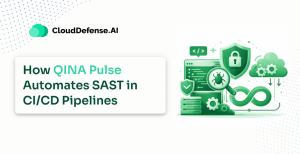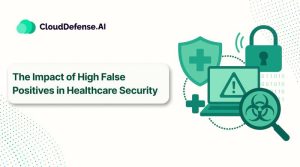Application security is a critical aspect of the software development lifecycle (SDLC), as vulnerabilities can emerge at any stage.
Build-Time vs Run-Time Security highlights two essential layers of defense that work together to protect applications. Build-time security plays a key role by identifying and addressing potential flaws early in the development process, preventing them from reaching production. Once the application is live, run-time security steps in, continuously monitoring and defending against threats while the application is in operation.
For cloud-native applications, both layers of security are required, offering complete protection from the initial stages of code creation to real-time defense, ensuring resilience against ever-evolving cyber threats.
Understanding Build-Time Security
Build-time security refers to measures implemented during the development phase to identify and fix vulnerabilities early, preventing security flaws from reaching production.
When it comes to securing applications, addressing vulnerabilities only after deployment is insufficient. Build-time security focuses on identifying and addressing issues early in the development process, setting the foundation for a more robust and secure application from the start.
Key Practices in Build-Time Security:
- Static Code Analysis involves scanning the source code for potential vulnerabilities without running the program. It’s like reviewing a blueprint before construction begins, identifying weak points that could later become serious security risks.
- Dependency Scanning: Open-source libraries and dependencies are essential in modern development, but they can introduce hidden vulnerabilities. Scanning these dependencies ensures that no malicious or outdated components enter your application.
- Configuration Management: It is crucial to ensure that your application’s configurations and settings are secure during the build process. Misconfigurations can lead to major vulnerabilities, and addressing them early can prevent these issues from slipping through the cracks.
The Benefits of Build-Time Security:
- Early Detection of Vulnerabilities: The sooner vulnerabilities are found, the easier they are to fix. Catching issues during development prevents costly remediation efforts later on.
- Cost-Effective Remediation: Fixing security flaws before deployment is far less expensive than dealing with breaches after launch. It’s an innovative and proactive approach to saving time and money.
- Prevention of Security Flaws Before Deployment: Ultimately, build-time security helps ensure that only the most secure, well-tested code makes it into production. This minimizes the risk of security breaches and maximizes the integrity of your application from the outset.
Integrating these practices into your development lifecycle minimizes the risk of security flaws and fosters a security culture throughout every phase of your application’s life. Think of build-time security as a proactive investment that yields long-term benefits, ensuring your application’s resilience against potential threats at the outset.
Understanding Run-Time Security
Run-time security refers to protecting applications during execution in production environments, focusing on real-time threat monitoring, anomaly detection, and intrusion prevention to prevent active attacks.
While build-time security sets the stage, run-time security takes over once your application is live, ensuring ongoing protection against real-time threats that can’t be anticipated during development. It focuses on securing applications while they’re running in production environments, providing dynamic and adaptive defenses against active attacks.
Key Practices in Run-Time Security:
- Real-Time Threat Monitoring: Constant surveillance of applications as they operate, identifying and responding to any suspicious activities or potential breaches as they unfold.
- Anomaly Detection: This practice focuses on spotting deviations from normal behavior. By continuously analyzing application patterns, it can catch unexpected actions that might indicate an attack, like unusual login attempts or sudden spikes in traffic.
- Intrusion Prevention Systems (IPS): IPS proactively block malicious activity, such as unauthorized access or data manipulation, ensuring attackers are stopped in their tracks before they cause harm.
The Benefits of Run-Time Security:
- Protection Against Active Threats: While build-time security prevents known vulnerabilities, run-time security defends against real-time attacks, ensuring that your application stays protected once it’s exposed to the internet.
- Detection of Issues Not Identifiable During Build-Time: Some security risks only emerge once an application is running in its production environment. Run-time security identifies these elusive threats, which might not have been apparent during the development stage.
- Continuous Security Posture Assessment: Run-time security doesn’t just react to threats; it continuously evaluates your application’s security posture, adapting to new challenges and evolving threats. This ensures that your defenses are always up-to-date.
Run-time security acts like a vigilant shield, continuously defending against evolving risks, even after your application is live. It provides an essential layer of protection to ensure that your cloud-native workloads remain safe and resilient in the constantly changing landscape of cyber threats.
Key Differences Between Build-Time vs Run-Time Security
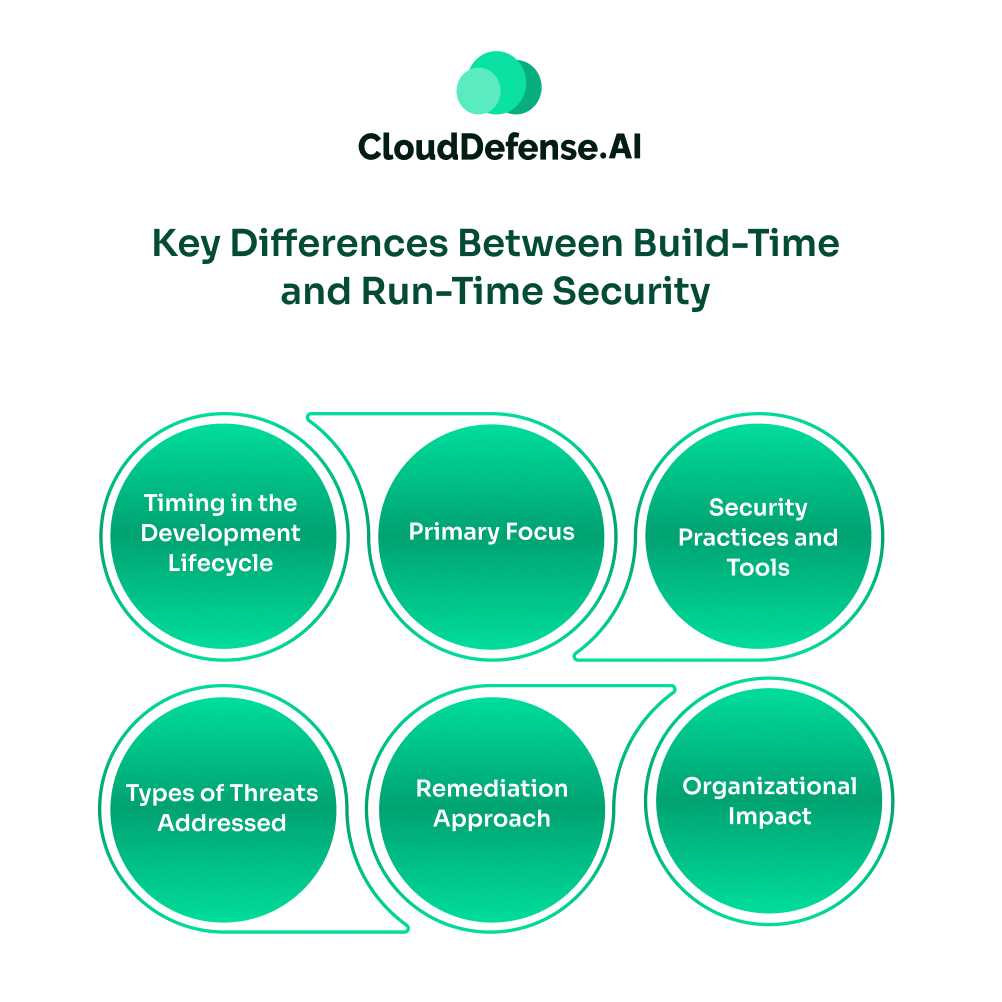
While both build-time vs run-time security are crucial for protecting applications, they serve different purposes at distinct stages of the software development lifecycle (SDLC). Understanding their differences helps organizations implement a comprehensive security strategy that ensures applications remain secure from development to deployment and beyond.
Timing in the Development Lifecycle
Build-time security occurs during development, addressing vulnerabilities early to prevent flaws in production. This proactive approach is cost-effective, reducing the risk of severe breaches later.
Run-time security is implemented once the application is live, continuously monitoring and defending against active threats that may have gone undetected during development. Real-time monitoring remains essential as new vulnerabilities can emerge post-deployment.
Primary Focus
Build-time security aims to prevent vulnerabilities in code before release. By applying security measures during development, organizations can reduce the risk of flaws in production. This includes secure coding practices, dependency management, and infrastructure configuration to lower attack vectors.
Run-time security, however, is reactive, safeguarding applications while they operate. Even with effective build-time security, new threats, misconfigurations, and zero-day vulnerabilities may emerge. Run-time security monitors application behavior, and detects anomalies to mitigate the impact of incidents.
Security Practices and Tools
Organizations enforce build-time security using Static Application Security Testing (SAST) to scan for vulnerabilities before deployment. Software Composition Analysis (SCA) identifies risks in third-party libraries to prevent security gaps. Infrastructure as Code (IaC) scanning secures cloud configurations before launch. These practices enhance security prior to production.
In contrast, run-time security relies on continuous monitoring to detect and respond to real-time threats. Intrusion Prevention Systems (IPS) block unauthorized access, while behavioral anomaly detection alerts security teams to suspicious activities. These tools protect applications against emerging attack vectors.
Types of Threats Addressed
Build-time security addresses code vulnerabilities, misconfigurations, and insecure dependencies before exploitation, reducing risks at their source. By ensuring the integrity of the codebase and dependencies, it establishes a strong foundation for secure development.
Run-time security defends against real-time attacks, unauthorized access, insider threats, and zero-day vulnerabilities post-deployment. In dynamic environments, new risks can surface after launch. It ensures that vulnerabilities detected in production can be mitigated before causing significant harm.
Remediation Approach
Build-time security emphasizes proactive vulnerability remediation before deployment, allowing fixes early in development. This cost-effective strategy reduces emergency patches by addressing risks pre-release, ensuring a strong security posture from the outset.
In contrast, run-time security demands quick detection and mitigation of active threats. It uses automated techniques like isolating compromised workloads and blocking suspicious activities. Since threats can arise anytime, run-time security enables real-time responses to minimize damage.
Organizational Impact
Build-time security focuses on integrating security measures early in the SDLC that helps in reducing the attack surface of the organization. Moreover it saves the organization from fixing any vulnerability in the deployment stage which are generally more expensive. The integration of security early in the development phase also establishes a proactive security approach and promotes a security-first mindset among all the developers. The stringent security checks from the beginning that helps in reducing any fixing tasks after deployment, leading to faster release cycles.
On the other hand, run-time security is all about providing your organization real-time visibility into active threats and providing a quick response. Even if a security threat bypasses all the control, run-time security makes sure all the critical applications remain functional, ensuring business continuity. By preventing active and zero day security threats, it minimizes all the financial loss associated with business downtime and compliance fines. It helps in gathering all the incident data that not only helps in investigation but also helps with compliance audits. The continuous monitoring and logging enables your organization to ensure adherence to compliance requirements.
The Importance of Integrating Build-Time and Run-Time Security
Modern applications face ever-evolving cyber threats, making both build-time and run-time security essential for comprehensive protection. Build-time security ensures that vulnerabilities are detected and resolved early in the software development lifecycle (SDLC), preventing security flaws from reaching production.
However, no application is ever completely free of risk, which is where run-time security becomes critical. It continuously monitors applications in real-world environments, detecting and mitigating active threats, including zero-day attacks, unauthorized access, and insider threats.
Organizations develop a multi-layered defense strategy by combining both security approaches, reducing risks during development and providing real-time protection in production. This holistic approach reduces remediation costs, improves compliance, and strengthens an application’s overall security posture.
In the current cloud-native world, where applications continuously change, having a cohesive security strategy for both build-time and run-time is crucial to stay resilient against cyber threats, while also ensuring operational efficiency and effectiveness.
With time, the number of cyber attacks are increasing, expanding the threat landscape. In 2021, there was a staggering increase in supply chain attack which rose to 650%. According to reports, there were an approximated 12,000 attacks alone in 2021. Many reports also state that container images used during application developments carries an average 180 vulnerabilities Most containers that are leveraged have at least one high-impact vulnerability. The gradual increase in supply chain attacks and presence of vulnerabilities necessitates the integration of build-time and runtime securities.
Best Practices for Implementing a Combined Security Approach
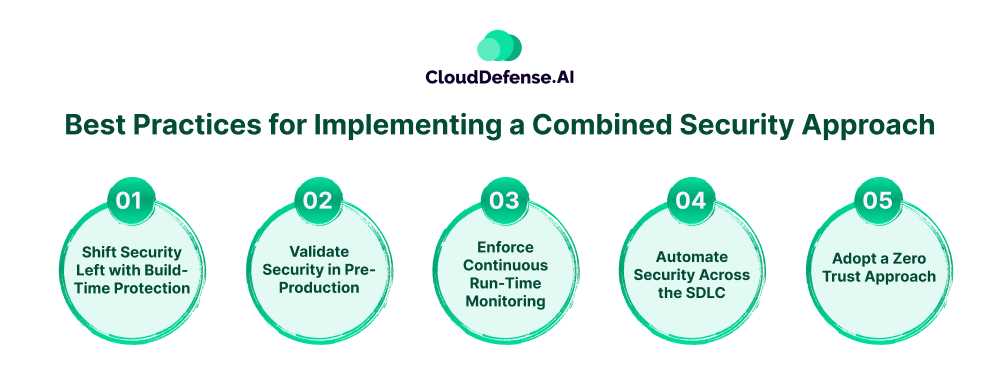
To achieve comprehensive application security, organizations must integrate both build-time and run-time security into their DevSecOps strategy. CloudDefense.AI offers a powerful solution by providing SAST, DAST, SCA, and WorkloadShield Runtime Security, ensuring end-to-end protection from code development to production execution.
Shift Security Left with Build-Time Protection
Implement security early in the development lifecycle to detect vulnerabilities before deployment. CloudDefense.AI’s SAST (Static Application Security Testing) scans source code for security flaws, while SCA (Software Composition Analysis) ensures third-party dependencies are secure.
Validate Security in Pre-Production
Use DAST (Dynamic Application Security Testing) to test applications in real-world conditions before release. CloudDefense.AI helps identify vulnerabilities that only surface during execution, ensuring stronger pre-production security.
Enforce Continuous Run-Time Monitoring
Even with strong build-time security, real-time threats remain a risk. CloudDefense.AI’s WorkloadShield Runtime Security provides continuous monitoring, anomaly detection, and automated threat mitigation, keeping workloads secure in production.
Automate Security Across the SDLC
Automation minimizes human error and ensures consistent security enforcement. CloudDefense.AI integrates seamlessly into CI/CD pipelines, automating scans, threat detection, and compliance enforcement at every stage.
Adopt a Zero Trust Approach
Enhance security by enforcing strict access controls and real-time policy enforcement. CloudDefense.AI’s WorkloadShield applies zero-trust security policies, preventing unauthorized access and securing workloads dynamically.
Organizations can utilize CloudDefense.AI’s comprehensive security suite to establish a strong, integrated strategy that keeps applications secure from development through to production, while actively addressing risks at every phase.
Get Complete Application Security with CloudDefense.AI
Securing cloud-native applications requires more than just patchwork defenses—it demands a unified strategy from code to cloud to runtime. CloudDefense.AI’s Cloud-Native Application Protection Platform (CNAPP) delivers hurdle-free, end-to-end security, ensuring threats are identified and mitigated at every stage of the software lifecycle.
All-in-one Application Security with CloudDefense.AI CNAPP
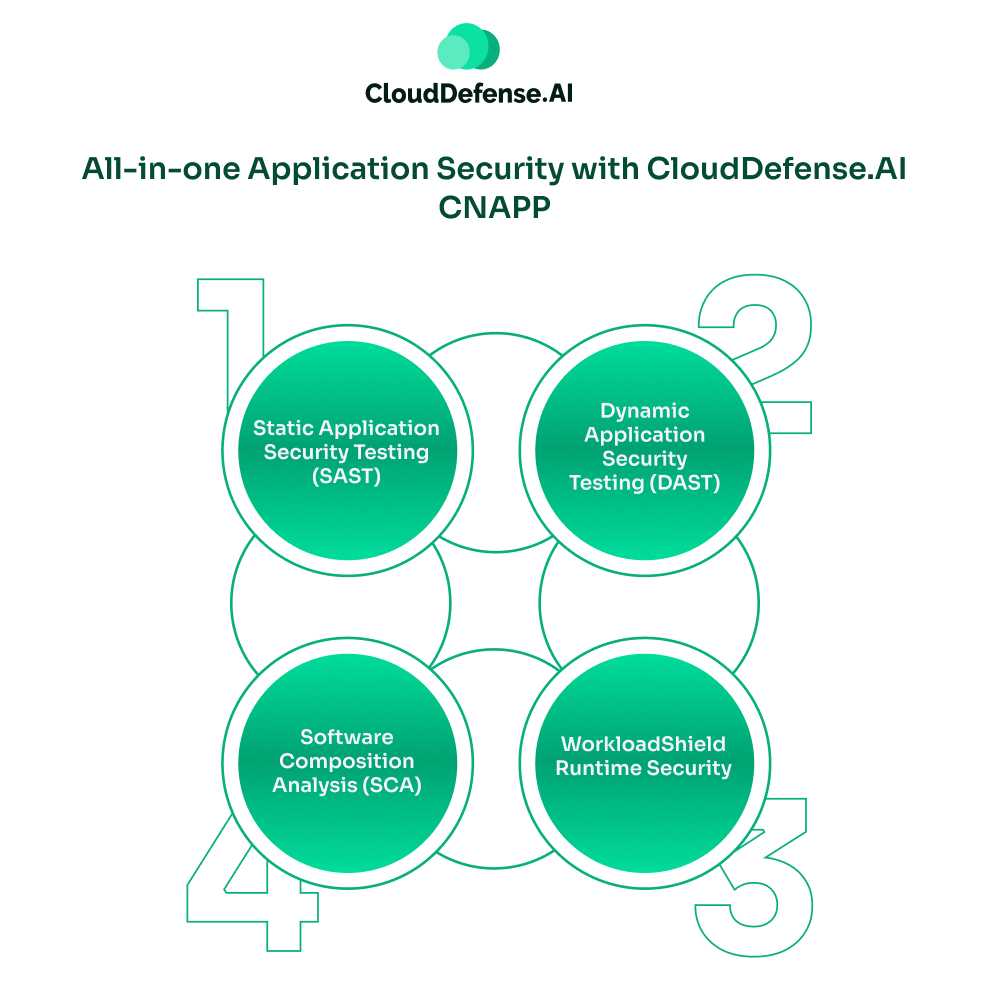
CloudDefense.AI’s CNAPP integrates multiple security tools into a unified platform, ensuring your applications are protected from development through deployment and beyond. Key features include:
- Static Application Security Testing (SAST): Analyze your source code for vulnerabilities during the development phase, enabling early detection and remediation of security issues.
- Dynamic Application Security Testing (DAST): Assess your running applications to identify potential vulnerabilities in real-time, ensuring robust protection against active threats.
- Software Composition Analysis (SCA): Examine third-party libraries and dependencies for known vulnerabilities, ensuring all components of your application are secure.
- WorkloadShield Runtime Security: Monitor and protect your applications during runtime, providing continuous threat detection and automated response to potential security incidents.
By consolidating these essential security functions, CloudDefense.AI streamlines your security operations, reduces complexity, and enhances your organization’s ability to respond to emerging threats effectively.
Experience CloudDefense.AI Firsthand for Free!
Discover how CloudDefense.AI can fortify your application’s security posture with a personalized demonstration. Our experts will showcase the platform’s capabilities and discuss how it can meet your specific security needs.
Invest in complete application security with CloudDefense.AI’s CNAPP and ensure your cloud-native applications are protected against today’s complex cyber threats. Book a free demo now!

